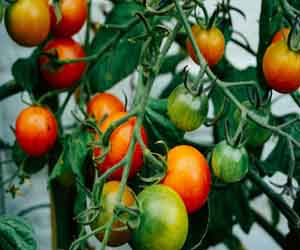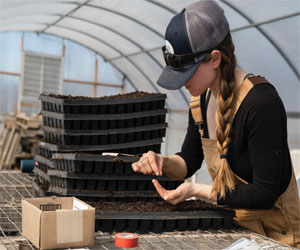

The Advantages Of Raised Beds

Raised beds are a popular gardening method that offers numerous benefits for both novice and experienced gardeners. These above-ground gardening structures, typically constructed from wood, stone, or other materials, have gained popularity for their ability to enhance plant growth, improve soil quality, and provide a range of practical advantages. In this article, we explore the advantages of raised beds and how they can transform your gardening experience.
Optimal Drainage And Soil Aeration
One of the primary benefits of raised beds is their superior drainage and soil aeration. Because the soil is elevated, excess water drains more efficiently, preventing waterlogged soil and root rot. This feature is especially valuable in regions with heavy rainfall or poor soil drainage. Additionally, the loose soil in raised beds allows for better aeration, promoting healthy root development.
Improved Soil Quality
Gardeners have control over the composition of the soil in raised beds. You can customize the soil mix to meet the specific needs of your plants. This flexibility is especially advantageous if your natural soil is of poor quality. Gardeners often use a blend of topsoil, compost, and organic matter to create a rich, fertile growing medium in their raised beds.
Warmer Soil And Extended Growing Season
Raised beds are known for their ability to warm up earlier in the spring and stay warmer in the fall, effectively extending the growing season. The elevated structure allows the soil to absorb and retain heat more efficiently. This feature enables gardeners to start planting earlier and continue harvesting crops later into the year.
Ease Of Maintenance
Working in raised beds is generally more comfortable due to the raised height, which reduces the need for bending and kneeling. This is particularly beneficial for individuals with mobility issues or back problems. Additionally, the defined and structured layout of raised beds makes it easier to manage and maintain your garden.
Weed And Pest Control
Raised beds help in controlling weeds, as the defined garden space minimizes the area where weeds can grow. Gardeners can install weed barriers or mulch within the bed to further prevent weed growth. Additionally, the elevated structure can deter some ground-dwelling pests and make it more challenging for them to access your plants.
Organized Planting
With raised beds, it's easier to plan and organize your garden. You can separate different crops in individual beds, making crop rotation and companion planting more manageable. The neat and structured layout not only looks aesthetically pleasing but also facilitates gardening practices.
Versatility And Accessibility
Raised beds can be installed in various sizes and shapes, making them adaptable to different spaces and garden designs. They are also a fantastic solution for urban or small-space gardening, allowing you to cultivate a garden on a patio, balcony, or rooftop.
Raised beds offer an array of advantages that can significantly enhance your gardening experience. From improved soil quality and drainage to extended growing seasons and easier maintenance, these elevated structures are a versatile and practical solution for gardeners of all levels of expertise. Whether you're a seasoned gardener or a beginner, raised beds can be a game-changer in creating a thriving, efficient, and organized garden.
Embracing Simplicity And Freedom
 2. Minimalist Living
2. Minimalist Living
The compact lifestyle often goes hand in hand with minimalist living. Minimalism is the art of living with less, focusing on quality over quantity, and savoring life's experiences over material possessions. This approach allows individuals to focus on what truly matters and brings joy, while reducing the overwhelming feeling of too much stuff.
3. Environmental Consciousness
Embracing a compact lifestyle also leads to a greater sense of environmental consciousness. Smaller living spaces mean reduced energy consumption, less waste, and a lower carbon footprint. This lifestyle choice can significantly contribute to a more sustainable and eco-friendly way of living.
4. Financial Freedom
Living a compact lifestyle can lead to significant financial benefits. With fewer expenses related to housing, maintenance, and possessions, individuals have the opportunity to save more, invest wisely, and gain financial freedom. This financial independence can open doors to new opportunities and experiences.
Cultivating Your Green Thumb
 Start Small: For beginners, it's often best to start with a small garden area. This can be a corner of your backyard, a few pots on your balcony, or even a sunny windowsill. Beginning with a small space allows you to learn the basics without feeling overwhelmed.
Start Small: For beginners, it's often best to start with a small garden area. This can be a corner of your backyard, a few pots on your balcony, or even a sunny windowsill. Beginning with a small space allows you to learn the basics without feeling overwhelmed.
Choose The Right Location: select a location that receives adequate sunlight for the plants you want to grow. Most vegetables and flowers require at least 6 hours of direct sunlight per day. If you have limited sun exposure, consider shade-tolerant plants like hostas or ferns.
Ensuring Safe And Sustainable Water Supply
 The Rainwater Treatment Process
The Rainwater Treatment Process
Filtration: The first step in rainwater treatment is filtration. This process involves the removal of physical impurities such as leaves, twigs, and debris. Mesh screens and sediment filters are commonly used for this purpose.
Storage: Rainwater is often collected in storage tanks or cisterns. Proper storage is essential to prevent the growth of algae and the contamination of the water by external factors.
Settling: Allowing the collected rainwater to settle can help separate fine particles and sediments that may have passed through the filtration process. This is especially important for improving water quality.
Chemical Treatment: To disinfect rainwater and eliminate pathogens, chemical treatments are employed. Chlorine or ultraviolet (UV) light can effectively kill bacteria and viruses, ensuring safe water for drinking and household use.
Carbon Filtration: Activated carbon filters can be used to remove organic compounds, odors, and residual chemicals from rainwater, enhancing its taste and quality.
Reverse Osmosis: For potable water, reverse osmosis systems can be used to further purify rainwater by removing dissolved minerals, heavy metals, and other contaminants.
Applications Of Treated Rainwater
Drinking Water: When appropriately treated, rainwater can be a safe and reliable source of drinking water in areas with limited access to clean water.
Revolutionizing Cleaning For A Sustainable Future
 3. Eco-Friendly Packaging
3. Eco-Friendly Packaging
Green cleaning isn't limited to the contents of the cleaning products but also extends to the packaging. Innovations in packaging include the use of recycled and biodegradable materials, as well as more efficient and space-saving packaging to reduce transportation costs and emissions.
4. Smart Cleaning Appliances
Smart cleaning appliances equipped with sensors and AI technology are making cleaning more efficient and eco-friendly. These devices can optimize cleaning routines, minimizing resource waste by adjusting water usage, detergents, and energy consumption based on the specific cleaning needs. For example, robotic vacuum cleaners can map out your home and clean only the areas that need attention, saving both time and energy.
5. Waterless Cleaning Technologies
Waterless cleaning innovations are revolutionizing the way we think about cleaning tasks that traditionally require large amounts of water. Dry steam cleaning, for example, uses superheated steam to clean and sanitize surfaces without the need for chemicals or excessive water usage. These methods are not only more environmentally friendly but also more efficient.
6. Sustainable Cleaning Pads
Innovative cleaning pads made from sustainable materials like bamboo or recycled fibers are not only effective at capturing dirt and dust but are also biodegradable. They offer a green alternative to disposable cleaning pads that contribute to waste and pollution.
7. Chemical-Free Electrolyzed Water Cleaners
Some cleaning appliances now generate electrolyzed water on the spot by passing an electric current through a mixture of water and salt. This creates a powerful, non-toxic cleaning solution that effectively sanitizes surfaces, eliminating the need for chemical cleaning agents.
Benefits Of Green Cleaning Innovations
Improved Indoor Air Quality: Green cleaning innovations typically reduce the release of volatile organic compounds (VOCs) and harmful chemicals, leading to better indoor air quality and improved respiratory health.
 The Rise Of Greenhouse Farming
The Rise Of Greenhouse Farming
Greenhouse farming, also known as protected cultivation, has witnessed a significant surge in popularity over recent decades. This surge can be attributed to several factors, including the increasing demands for year-round crop production, the need for protection against adverse weather conditions, and the conservation of resources in a sustainable manner.
Year-Round Crop Production
One of the most notable advantages of greenhouse farming is the ability to grow crops throughout the year, regardless of the external climate. Greenhouses provide a stable and controlled environment where temperature, humidity, and light levels can be regulated to meet the specific needs of different crops. This means that farmers are not restricted to the traditional growing seasons, leading to increased crop diversity and a more reliable food supply.
Optimal Environmental Control
Greenhouses offer precise control over environmental factors. With advanced climate control systems, farmers can adjust temperature, humidity, and CO2 levels to create ideal conditions for plant growth. This level of control minimizes the impact of extreme weather events, pests, and diseases, resulting in higher crop yields and quality. It also allows for the cultivation of crops that might not thrive in local climates.
Resource Efficiency And Sustainability
Greenhouse farming is inherently resource-efficient. By retaining heat and moisture, greenhouses reduce water usage and protect against soil erosion.
Paving The Way To A Sustainable Future
 1. Electric Vehicles (EVs): Electric vehicles have gained significant popularity as a greener alternative to traditional gasoline and diesel-powered cars. EVs run on electricity stored in rechargeable batteries, producing zero tailpipe emissions. The adoption of electric cars is on the rise, thanks to advancements in battery technology, extended driving ranges, and the expansion of charging infrastructure. EVs significantly reduce carbon emissions, air pollution, and dependence on fossil fuels.
1. Electric Vehicles (EVs): Electric vehicles have gained significant popularity as a greener alternative to traditional gasoline and diesel-powered cars. EVs run on electricity stored in rechargeable batteries, producing zero tailpipe emissions. The adoption of electric cars is on the rise, thanks to advancements in battery technology, extended driving ranges, and the expansion of charging infrastructure. EVs significantly reduce carbon emissions, air pollution, and dependence on fossil fuels.
2. Hybrid Vehicles: Hybrid vehicles combine traditional internal combustion engines with electric propulsion systems. These vehicles can operate on electric power at low speeds and switch to the internal combustion engine at higher speeds or when additional power is needed. Hybrid technology improves fuel efficiency and reduces emissions, making it an effective transition solution for those not yet ready to fully commit to electric vehicles.
3. Public Transportation: Efficient and eco-friendly public transportation systems, such as buses and trains, play a vital role in reducing the number of private vehicles on the road. Modern public transportation options often include electric or hybrid buses, which produce fewer emissions and offer a more sustainable means of moving people within urban areas.
4. Bicycles And Electric Bikes: Cycling and electric biking are eco-friendly, healthy, and efficient modes of transportation. These options produce zero emissions and promote physical activity, reducing the overall carbon footprint associated with commuting. Many cities worldwide are investing in cycling infrastructure to encourage this sustainable means of transportation.
The Dawn Of Intelligent Living
 Smart Living At Its Best
Smart Living At Its Best
Future-ready homes are characterized by their integration of cutting-edge technology, automation, and intelligent systems. These homes use the power of the Internet of Things (IoT) to create an interconnected ecosystem, where devices and appliances can communicate and work together seamlessly. From lighting and climate control to security and entertainment, every aspect of daily life is optimized for convenience and efficiency.
Energy Efficiency And Sustainability
A central focus of future-ready homes is sustainability. These homes incorporate energy-efficient solutions that not only reduce utility costs but also minimize environmental impact. Solar panels, smart lighting, and advanced insulation systems are just a few examples. Future-ready homes can harvest and store energy, monitor usage, and make real-time adjustments to conserve resources.
Security And Peace Of Mind
Security is paramount in future-ready homes. Advanced surveillance systems with high-resolution cameras, motion detectors, and smart locks provide unparalleled protection for homeowners.
Nurturing Our Lifeline
 Human Survival: Water is essential for drinking, cooking, and sanitation. Access to clean and safe water is a fundamental human right, yet it remains out of reach for millions around the world.
Human Survival: Water is essential for drinking, cooking, and sanitation. Access to clean and safe water is a fundamental human right, yet it remains out of reach for millions around the world.
Agriculture: Agriculture is the largest consumer of water globally. Crops and livestock rely on water for growth and sustenance, making it indispensable for food production.
Ecosystems: Aquatic ecosystems, from rivers and lakes to oceans, support biodiversity and help maintain the balance of nature. These ecosystems provide essential services such as water purification and flood regulation.
Industrial Processes: Industries depend on water for manufacturing and energy production. Water resources play a pivotal role in supporting economic activities and industrial growth.
Challenges Facing Water Resources
Despite the undeniable importance of water resources, they face several challenges:
Water Scarcity: Many regions worldwide are grappling with water scarcity, where the demand for water surpasses the available supply. This issue is exacerbated by population growth, urbanization, and climate change.
Water Pollution: Pollution from agricultural runoff, industrial discharges, and inadequate sanitation contaminates water sources, making them unsafe for consumption and detrimental to ecosystems.
Inefficient Water Use: Wasteful water practices in agriculture, industry, and households contribute to water stress and resource depletion.
Deteriorating Ecosystems: The degradation of aquatic ecosystems harms biodiversity and impairs the ability of natural environments to purify water and regulate local climates.
Safeguarding Our Precious Water Resources